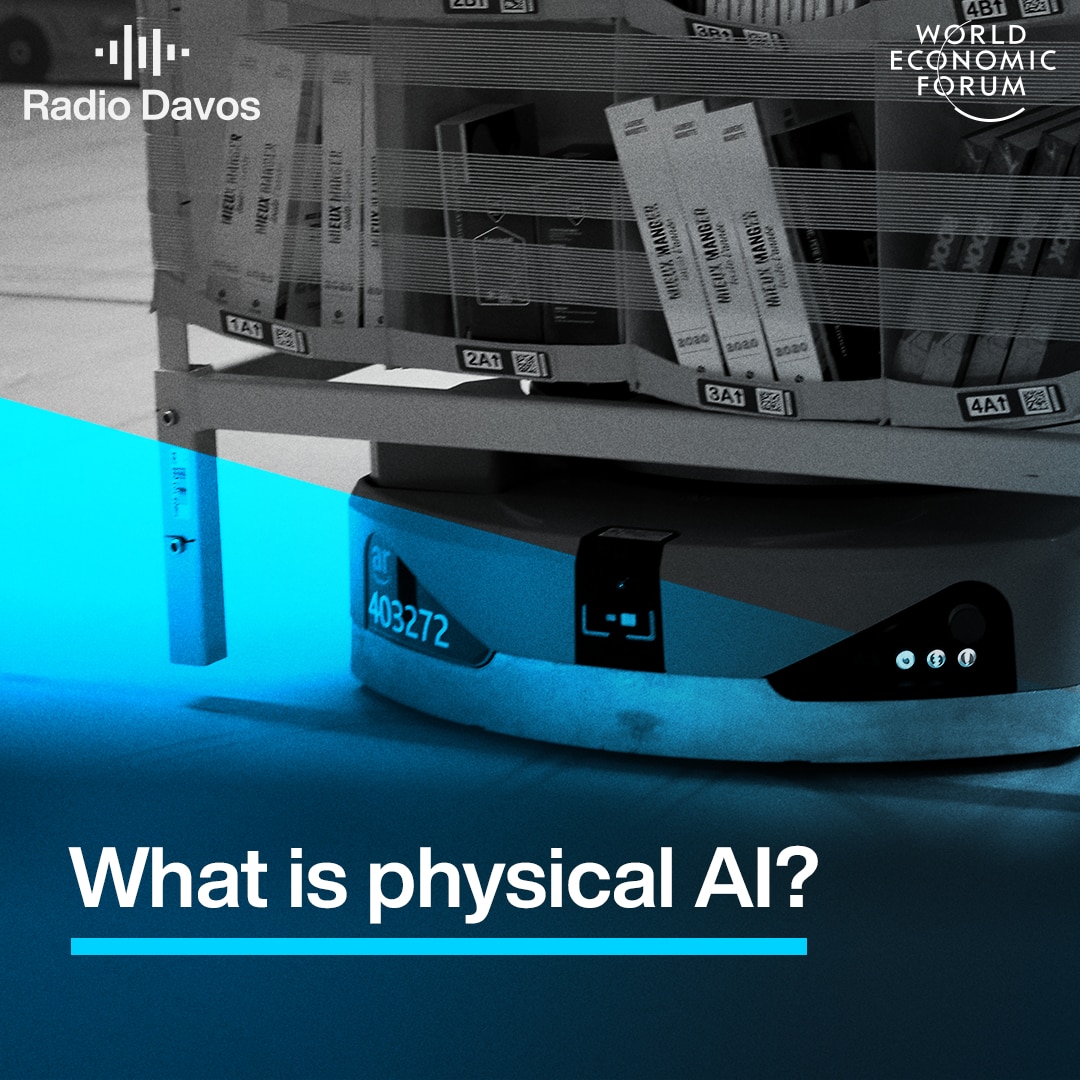Stock markets and supermarkets: how business is deploying AI
ポッドキャスト・トランスクリプト
This transcript has been generated using speech recognition software and may contain errors. Please check its accuracy against the audio.
David Schwimmer, Chief Executive Officer, London Stock Exchange Group (LSEG): Three years. Can you imagine where the world's going to be in three years? How about 3 to 6 months?
Robin Pomeroy, host Radio Davos: Welcome to Radio Davos, the podcast from the World Economic Forum that looks at the biggest challenges and how we might solve them. This week, in the second in a series looking at how AI is transforming industries, we hear from two sectors at the forefront of AI deployment. Financial services:
David Schwimmer: When we make that available to, for example, a big bank, they'll look at it, they'll immediately understand the value, the use case, and in many cases they'll be really excited about it.
Robin Pomeroy: And consumer goods:
Athina Kanioura, Chief Strategy and Transformation Officer, PepsiCo: Consumer and human centricity has always been our motto. But now with GenAI, we can truly make it the reality in every part of how we manage the business.
Robin Pomeroy: The head of the the London Stock Exchange Group explains why, for the financial sector, managing the risks posed by generative AI is vital.
David Schwimmer: Everyone is familiar now with the concept of hallucinations.
You can't be 95% right if you're using AI on financial analytics. Our customers expect accuracy and correct results, I dare say, all the time
Robin Pomeroy: And the Chief Strategy and Transformation Officer at PepsiCo shares some of the lessons the consumer goods sector is learning as it scales up the use of AI.
Athina Kanioura: Invest in your infrastructure because it's a necessary foundation for GenAI. And invest in your people with the right learning, upskilling, reskilling and change management practices so the two of them can be an unbeatable combination in terms of AI adoption.
Robin Pomeroy: Follow Radio Davos wherever you get your podcasts, or visit wef.ch/podcasts where you will also find our sister programmes, Meet the Leader and Agenda Dialogues.
I’m Robin Pomeroy at the World Economic Forum, and with look at how AI is being deployed across the financial services and consumer goods sectors...
So if we're not driving that kind of pace ourselves, then we're leaving opportunity on the table.
Robin Pomeroy: This is Radio Davos
Robin Pomeroy: To talk about how AI is transforming the financial sector, I'm joined by Drew Propson. Drew, how are you?
Drew Proposon, Head, Technology and Innovation in Financial Services, World Economic Forum: I'm doing well, Robin. How are you doing?
Robin Pomeroy: I'm doing well, thank you. Tell us what you do at the World Economic Forum.
Drew Proposon: Yes, I head up the World Economic Forum work on technology and innovation in financial services. And we have several different initiatives in this area and really across all of the initiatives we aim to answer primarily three key questions.
The first of these is how is tech innovation shifting and shaping financial services, so ultimately then the financial system as well.
The second is as technologies continue to evolve, where are we maybe seeing new risks surfacing as a result that we need to be curbing before they become systemic? So here, of course, public-private cooperation plays an important role.
And then the third piece is, how do we ensure that funding continues to flow towards innovation in financial services, which is certainly an important key part for innovation.
Robin Pomeroy: And you published in Davos this paper, part of the Industries in the Intelligent Age white paper series, on financial services. Can you give us some idea of, if I were to start reading that, what I would find in there?
Drew Proposon: Yes, certainly. So the financial sector is really implementing AI in several ways, in a number of ways. In fact, it's the sector that spends most heavily on artificial intelligence. So I think the numbers have recently been coming out about, you know, in 2023, 35 billion was spent. But now we know for 2024, 45 billion US dollars was spent last from the financial sector.
Robin Pomeroy: Spent on what kind of thing.
Drew Proposon: Spent on AI in general in terms of offering a lot of different deployment opportunities.
So if we look at all of the use cases available, a lot of the money has been spent primarily on using AI to streamline operations and reduce risk.
So for example, one very common use is using AI for fraud detection. So financial services firms are taking advantage of the pattern recognition capabilities of AI combined with machine learning. And they're able to monitor transactions, and then of course detect anomalies that would signal fraud. So certainly a very strong use case there, being deployed across the board.
Another one that is really taking advantage of developments in generative AI, the recent developments there, is the creation of internal chatbots that are supporting staff in getting them the information they need, which can be pulled from really complex or lengthy documents in a short amount of time. So this is also something we're seeing pretty heavily within financial services firms.
Interestingly, a lot of different firms are giving them creative names to help with adoption as well so that the internal staff are using them regularly.
Robin Pomeroy: Creative names?
Drew Proposon: Yes, for example, BNY's new AI tool is named Eliza, and this is in honour of the wife of Alexander Hamilton, who is the bank's corporate predecessor. So it's just fun to see how people are playing with the different names.
Robin Pomeroy: I thought they'd all be named after fruit. That's what happened in the 80s, isn't it, with Apple being maybe the main survivor of that.
Drew Proposon: Maybe that's the next wave, we'll see.
Robin Pomeroy: The next wave is historical figures, okay.
We're going to talk to, or we're going to listen to, I've already talked to him, David Schwimmer. Tell us who he is, he's not Ross from Friends. And I did discuss this with him, although you won't hear that in the interview. He's never even met Ross from friends, the other David Schwimmer. Tell us who this David Schwimmer is.
Drew Proposon: Yes, so David Schwimmer is the CEO of London Stock Exchange Group, which is commonly known as LSEG. And LSEG is a leading global financial infrastructure and data provider, so certainly an important entity within the global financial system.
Robin Pomeroy: It was such an interesting interview to do.
One of the points he made was the financial sector is probably leading the pack across industry sectors when it comes to implementation of AI. And the main reason he gives for that is they've just got more data than everyone else, and it's usually pretty clean, good usable data. Would you agree with that?
Drew Proposon: 100%. Yes. I think it's excellent that David mentions this. I think is a really good starting point for people to understand a little bit about the financial sector and why they're using AI. Really it is a very data-heavy, very information-heavy environment, and it can obviously be a huge benefit if you're able to take this data, run advanced analytics on it, and extract insights pretty quickly.
Robin Pomeroy: One of the points I think he makes also, though, is it's extremely important to avoid what's known as hallucinations in AI.
All of us who've been using it the last couple of years have stumbled across nonsense being outputted by AI. That's fine if you're writing a poem or drafting a letter or something. If you're trading millions of dollars and you're doing it on the basis of a hallucination or just incorrect output from an AI bot, that could have serious consequences.
Drew Proposon: Absolutely and and one of the things that David mentions too is just the importance of having, the quality of your data needs to be very very high, right?
So beyond hallucinations if you don't have good quality data, and it's not well organised, you're going to end up with outcomes that maybe don't make a lot of sense or that could lead to large errors So that piece is really important
Robin Pomeroy: One of the things you just mentioned, Drew, actually, was that they use these internal kind of chat bots to interrogate some of this data. As we'll hear in this interview, he says this is something they've made available to their customers, that they can interrogate an enormous database with natural language. So you'll just ask it questions and it will come back with the answer. This is a quote from him. "What took something like 27 clicks through the database before, now is answered in a simple question and answer format." Sounds like a real game changer.
Drew Proposon: Absolutely, and it's a great example of a use case that does work directly with consumers, right? I had mentioned that a lot of the use cases currently are on the back end streamlining operations It's just because that's where you can see your return on investment so quickly.
But there is a lot being developed right now that is really working to interact with the customers as this example that David comes up with you know really just comes to light.
It's wonderful to see this a lot more is going on in this space, but it's the perfect example of something that's ongoing
Robin Pomeroy: So as the financial sector is kind of a pioneer in the deployment of AI, are there lessons that that sector has learned? Do you think, what could other sectors learn from the financial sectors?
Drew Proposon: Yes, so the financial sector is continuing to push the envelope and be very innovative at the same time.
Trust is at the core of the financial system. So one needs to be very, very careful with the deployment that there aren't errors in this and that one is keeping customers and our financial system safe.
So I think that balance of pushing the envelope on being innovative while also making sure you have your checks and balances in place to keep the risks at bay is something that others can learn.
And maybe I'll just mention one thing that David points out that I think is also worth noting is just, he speaks a lot about the partnerships that LSEG has with others. He mentions Microsoft in particular, but I would say this is something that we see across the financial system, but also I think other industries can really learn from the financial sector here.
You cannot build everything in-house. Things are moving just way too quickly and that pace of change is really continuing to accelerate. So the more that you can partner with others that have their fingers on the pulse of different components of AI and the technological innovations, the better off you'll be. So those partnerships we certainly see continuing.
Robin Pomeroy: Absolutely. He talks a lot about the partnerships. Well, let's listen to him now. Thanks to you, Drew, Drew Propson, Head of Technology and Innovation in Financial Services at the World Economic Forum. And this is David Schwimmer, Chief Executive Officer of the London Stock Exchange Group.
Robin Pomeroy: David, how are you?
David Schwimmer: Great. Great to be here, Robin. Thanks a lot.
Robin Pomeroy: Let me read you a paragraph, one of the key messages from the World Economic Forum's report on financial services and AI. It says financial services firms invested $35 billion in in 2023, and that amount could rise to $97 billion by 2027.
Financial services is one of the sectors this really driving quickly ahead with AI. Why do you think that is?
David Schwimmer: So I think there are a couple of aspects to that.
One is that the financial sector is and has been for many, many years somewhat overwhelmed with information, with data. And the value add that AI can bring in terms of really processing that massive amount of data and extracting insight from it very quickly is incredibly powerful for the financial sector.
There are a number of other aspects of that or nuances to it, but that's sort of the, the fundamental opportunity set.
Robin Pomeroy: Within the company where you work. how is AI transforming the company and what you do?
David Schwimmer: In a number of different ways.
So LSEG, London Stock Exchange Group, we have one of the world's largest data and analytics businesses. And we have an enormous amount of information. We are providing updates to our customers every second. Something like 7.3 million pricing ticks per second, billions of data messages, a huge amount of information, a huge amount that needs to be analyzed, processed. And then our customers want to extract insight from.
So to the extent that we can make that easier, more efficient and more accessible to someone who might not be an expert at navigating a complex database or data set. Again, very powerful, very valuable for our customers.
And just to to give you an example, we have a data set on funds and fund analytics called Lipper. It's been around for a long time. Has a massive amount of data. Great data, great analytics, really hard to navigate the database. You have to be a real expert in terms of navigating it.
We have put AI functionality on top of that that allows our customers to basically use natural language to ask for information from that database. And it can be the natural language of their choice. They can ask in Japanese if they want to. And instead of having to have real expertise in navigating a complex database, they ask that question in natural language. And within a matter of seconds, they'll get the answer. That's a huge difference in terms of accessibility. What took something like 27 clicks through the database before now is answered in this simple question and answer format.
So those kinds of benefits, really powerful.
Robin Pomeroy: In the wider industry sector, there's a lot of investment, a lot of adoption going. What are the hurdles though that the companies may be experiencing?
David Schwimmer: So, there are hurdles and it is not all smooth sailing.
And a couple just to work through it. Everyone is familiar now with the concept of hallucinations. And in our sector, in the financial sector, you can't be 90% right. You can't be sort of 95% right if you're using AI on financial analytics. Our industry, our customers expect accuracy and correct results. I dare say all the time.
So that means you have to have a much greater focus on the quality and the integrity. And I'll say also the auditability of the data that goes into, for example, a large language model that is really driving a lot of these results that we've seen over the last couple of years.
Let me just unpack that a little bit because in simple terms, when you put bad data into one of these models, you're going to get bad outputs. It's the the cliche of garbage in, garbage out.
If you have strict controls over the quality of the data that is being used in a large language model, and you can validate all of that data and you can provide that capability after that data comes out on the other end through the large language model to audit where it came from, effectively double clicking on it to find out the source of that data was the source of that conclusion was this data, then not only do you significantly reduce the amount of errors or hallucinations, but you also give the user the ability to actually check where the information came from if they see something that does strike them as either surprising or a bit odd or just they're curious where the information came from.
So that's one area in terms of making sure that the quality of the data is very, very high.
There are a number of other aspects to the use of AI in this industry. The financial sector tends to be highly regulated, tends to be risk averse. And so as we have built AI into a number of products, and again, I'm happy to give you an example, when we share that with our customers, we get a different reaction from our customers depending on how risk averse they are, how regulated they might be.
And so, for example, we have a product called Financial Meeting Prep, and this is a product that we have built with Microsoft. We have a very significant partnership with Microsoft where they've taken a stake in us, an ownership stake in us, their head of cloud and AI's on our board, and we are actively building a number of products together.
One of those products is this Meeting Prep product and it is available on Teams screen. So Microsoft Teams, you have a meeting, you use this function, you click on this button and indicate whom you are meeting with and within less time than it is taking me to describe this to you, you will have a GenAI generated briefing memo on that person using our data, public data information on the company, stock price, news, research, all kinds of data that we make available. And combined with the information that you have on that person in your emails, your files, maybe your CRM system if you permission it.
So that's again, very powerful. There are lots of people out there who spend a lot of time preparing briefing memos for meetings. But as a product is a great example where when we make that available to, for example, a big bank, they'll look at it, they'll immediately understand the value, the use case, and in many cases they'll be really excited about it.
But then it will have to go through their various risk management processes because it is, one, it's using AI and they want to make sure they understand that. Two, it is using AI to often integrate confidential information within their files, within their systems into this briefing memo product. They want to make sure that confidential information is protected appropriately.
So with those kinds of customers, we have seen a slower adoption curve as they go through a risk committee process or a new products committee process. And that's fine. And that I think makes a lot of sense. We have some other customers, might be smaller institutions, might be hedge funds, etc.. They look at this, they say, this is amazing, where do we sign up? And they're using it now.
So I think that range of adoption, frankly, is not surprising and in many ways very healthy. And we work with partners, customers across that range.
But it's those kinds of things that our customers are working through and some of the risks associated with the adoption of these kinds of products.
Robin Pomeroy: You mentioned collaboration there with Microsoft. It strikes me that industries have to cooperate to really scale up implementation of AI. Could you give us any other examples of how you as a company have collaborated either with other companies or with academic institutions or whoever that might be? Very few companies can do this kind of thing on their own. Tell us something about collaboration.
David Schwimmer: So particularly in the area of AI, we have a lot of collaboration ongoing.
There is a lot that we're doing with Microsoft, as I mentioned, we have a great partnership with them. But we also work with a number of the other tech companies and a number of the other cloud providers. We have an operating philosophy of being poly cloud. We will work with our customers in whatever cloud environment they want to navigate. And so we make our data available in multiple different environments. So there's a lot of different collaboration effort there.
We are doing a lot with AI functionality internally in terms of our own operations, as many companies do. We have seen significant benefits in terms of integrating AI functionality to our customer service. And we have made our our customer service team approximately 50% more efficient and dramatically cut our what we call our MTTR, our median time to respond, to customer queries, using AI functionality. Basically, we took all of our internal documentation for how to do certain things or how to find data, and we put it on an internal large language model and we have made that model available to our customer service team. They use it when they're responding to customer queries. And I expect over time we will make that model directly available to our customers so that they can access it and ask questions directly.
So in that we tend to use open source models. And we have spent a good amount of time evaluating all of the different kinds of models out there. And I think some are good in some use cases, some are good in other use cases. Some are free, some are more expensive.
And so that's another example where we're working with many different partners in terms of incorporating a lot of this great technology in improving, transforming our business and serving our customers better.
Robin Pomeroy: Are people within the company excited about AI, are some people resistant about it? What's been the reception?
David Schwimmer: I would say generally excitement. We don't have a lot of resistance to the kind of progress that we're seeing, the kinds of efficiency we're driving, the kind of insight that is being created for our customers. All of those things are really important to how we operate as a company. And so I think by and large, our people are really excited about it.
There are certainly some areas where does it drive change. Can it drive disruption? Yes. But actually, we we as a company have as one of our values change and the embracing of change. And so when our people look at this, it fits squarely into that that notion of change to improve the business, change to improve how we how we serve our customers.
Robin Pomeroy: Has anything surprised you over how long you've been involved in implementing AI? Probably much longer than those of us who started using ChatGPT a couple of years ago. Anything through that journey blow you away?
David Schwimmer: So you're right. We have been using a lot of technology that some people might call AI for a number of years. Going back through machine learning is is a big part of a lot of the different things we do.
I would say you have seen a dramatic acceleration since November '22 when ChatGPT came out, when OpenAI really put that out there. And I would say the surprise has really been around the pace of change and the continuing acceleration in that.
And so, for example, our partnership with Microsoft, we announced that in December '22, so a few weeks after the ChatGPT announcement. And we had been working on putting this partnership together for almost a year and a half, and we had a lot of plans in a number of different areas. And since then we have been continuing to execute on those plans. We had three different sort of strategic workstreams. We've continued to execute in those three different areas, but the pace of improvement, the pace of migration of our data into an integrated architecture in the cloud, the embedding of AI functionality in a lot of our workflow, all of that has gone faster and continued to develop in a way that when we announced the partnership in December '22 I would not have predicted.
Robin Pomeroy: Why is that? Is that because the technology itself, are the models themselves, are improving quicker than anyone expected?
David Schwimmer: And so that's that's a big part of it. The technology is improving. There are things that we can do today that a year ago would have felt very different, felt very challenging.
So it's it's shifts in the technology. It's developments in our workforce and our team thinking differently. So that something that we might have planned to do in 2023, and the plan was, you know, this will take three years to deliver, when we look at it today, and I've actually had these kinds of conversations with the team, I will sometimes say them three years. Can you imagine where the world's going to be in three years? How about 3 to 6 months? And on one hand, that can be tough and challenging for the team. On the other hand, everyone sees how the world is is moving along. Everyone gets it.
So if we're not driving that kind of pace ourselves, then we're leaving opportunity on the table.
Robin Pomeroy: So looking three years in the future, which is a lifetime now, as you say, can you envisage, or is it impossible to, what amazing new applications might be available?
David Schwimmer: It's hard to describe anything specific other than an expectation that we will see stronger capabilities to navigate huge amounts of data quickly and put them in a functionality that creates a lot of value.
And so there's a there's discussion today of agenetic AI where you can basically have the AI do a multi-step task for you. I think there's a lot of opportunity for that in the financial sector, whether it is a young banker asking the AI functionality to prepare a pitch book with six different tabs in multiple kinds of analysis, or a research analyst running multiple different analyses.
So I think you'll see, I would expect a fairly consistent progression and improvement in the ability to provide those kinds of aids, services, compliments to the people who are working in this industry.
Robin Pomeroy: Agentic AI is a bit of a buzzword I think at this Davos, 2025. It strikes me as it's a bit like going from a 2D version to a 3D version of what we're doing right now. It's really hard to predict what actual products that could produce, but it's going to be a wild ride, I guess.
David Schwimmer: The way I think about it, and I don't claim expertise on a number of these topics as they, you know, blast along. But I'm continuing to try to learn as they go. But the way I think about it, if there's a multi-step process that can be broken down into individual steps, that can be tackled by AI, and then you put that together in the agenetic construct, you can see how powerful that can be. And again, we have a lot, there would be a lot of potential use cases in the financial sector.
Robin Pomeroy: And what about the drawbacks? A lot of people who aren't involved in the sector may not be aware that trading, for example, has been automated.
David Schwimmer: Electronified, yes.
Robin Pomeroy: In a in a dystopian sci fi way, you've got robots buying and selling assets on our behalf, or on behalf of the people lucky enough to have them. Is there...
David Schwimmer: We do have some risk management tools around that, but yes.
Robin Pomeroy: I'm going to ask two questions. Bad journalistic practice, but here we go. So there's that one - is there a dystopian future which we need to make sure we avoid? And also, you have of the great inequality in the world of access to technology and to financial services. AI is expensive. Might it not just further exacerbate, and the haves, the rich will get richer and the people who just aren't connected to this will be left out again. Maybe that's the same question because that's a dystopian future as well, but what are the drawbacks, potentially?
David Schwimmer: So I think there is a risk that we are creating just a wider dispersion. And if you see some cultures or societies taking advantage of this very powerful technology and raising growth and productivity and living standards, and then others are not participating in that being left further behind, I think that is a risk and I think that is an issue.
I think a way to address that, and I wouldn't claim that this addresses all of that because that's a huge issue, and it's not just about AI, is if you go to the fundamental role that the financial sector plays, it's about allocating capital and ideally allocating capital efficiently to the best possible use. And if we look at the challenges that the world faces today and there are plenty, you see the financial sector playing a role, sometimes successfully, sometimes not so successfully, but playing a role in the allocation of capital to address, for example, climate change or to address development needs.
I think that it's hard for the financial sector on its own based purely on profit motive to move all of the capital that is necessary to the parts of the world that may benefit most from that or that may need that. And so you do need the kind of partnership with government, with NGOs, and there may need to be some financial incentives associated with that.
To your first question about a potential dystopian outcome here. I don't think that the risks of AI in the financial sector are brand new. And so if you go back many, many years, we've had issues in the markets of, for example, flash crashes. The market crashed due to kind of the loop in program trading. And so that is has been a problem with some of the electronic trading. Crowded trades combined with electronically driven trade or trading coming out of algorithms are, you could say, a particularly risky combination when you have sort of a very broadly held conventional wisdom. You have a lot of capital in particular trades, whether it's a bunch of hedge funds in certain trades, whether it's a lot of investors putting on a quote unquote Trump trade, etc.. If there's a rush out of those trades driven by algorithms, that could be a disruption in and of itself.
So these kinds of risks have existed already. Could they be exacerbated by AI? Yes, they could. Are there mitigants for them? Yes. And we've seen that in a number of different markets. For example, circuit breakers on exchanges where if there is a a stock price movement of X percent, then there's a pause in trading. And we've seen that be very effective in certain areas.
I think you will have also seen the investors, the companies that are participating in these try to put in place various checks, risk management tools to deal with, for example, the the fat finger phenomenon of bad trades that are input and create some distortions in the market.
So long answer to your question. There are risks. The risks have been here with us for a number of decades. And I think there are mitigants. But it's probably something that the industry needs to pay very close attention to to see if there are other mitigants we need to put in place.
PepsiCO
Athina Kanioura: My job is extremely exciting because my responsibility spanned from everything in enterprise strategy, M&A, business development to of course, digital transformation and business transformation agenda, fully embedding AI in everything we do in the organization. So it's been a pivotal role for the transformation agenda of the company.
Robin Pomeroy: It's such an exciting time to be dealing with AI, I mean, within those four years, for the average person, maybe not in industry, generative AI hit us like a rocket maybe two years ago. I'm imagining four industries for a big company like PepsiCo, probably AI has been around, you've been using it much, much longer, right?
Athina Kanioura: Yeah. No, I mean, we have been using AI for more than a decade, especially if you were to think areas of forecasting and planning, on how we manage financial risk in the organization, in sales and how we're planning commercial execution.
But in the past years, we have seen a big pivot by leveraging GenAI, both in the strategy on how we redefine the technology advancements and how they impact the organization, but more importantly on how implementations will be totally revolutionized by using GenAI at its core.
And and we've always believed that you need a portfolio of technologies to become a reality to leverage GenAI.
So traditional AI, of course, it will be pervasive and has been pervasive in everything we do. GenAI is a much bigger promise where we see it will create so much interconnectivity across the different parts of the organization that will make us a faster, better and a stronger company for the future.
Robin Pomeroy: Can you give us some examples of that interconnectivity? That's really interesting because at the moment I get the impression a lot of people are using GenAI, but they will have a certain app to go into to create documents or to read documents, It's usually them working on their own. So what do you mean by interconnectiveness?
Athina Kanioura: Yeah. So I mean, a great example is how we are now doing innovation in the company.
Historically, we leveraged technology to do innovation in science. So R&D had a responsibility for a certain part of the innovation on product portfolio, on product lifecycle management. Then we would take it to the commercial teams to say, okay, how can I commercialize that innovation in terms of joint business planning with retailers? What should be the plan, how we should structure the agreements? And then you would have the marketing teams to say, okay, what does that innovation look like in terms of brand activation? So functional silos, even though it is one process.
Now, if you were to think of how GenAI changes everything, we are doing consumer first. So by looking at what are the consumer preferences, by talking to the consumers directly, by looking at, okay, what is your personalized experience that you would like also to materialize to a portfolio that is very tailored for you?
We now break down the consumer attributes to product attributes. So scale things, scale of millions of attributes that consumers want to combine and millions of product attributes that you have kind of really to transcend and connect with each other, to have the perfect score at the right time with the right offer for the consumer.
Now, future back, going back from that consumer vision, what do you need to do? Saying, okay, how does that translate to a consumer reality cross channel, digital commerce, social commerce, retailers, organized trade, additional trade. How does that translate to a product portfolio management that R&D needs to make sure that they deliver in time? How does that translate to supply chain reality in terms of I take another consumer vision and I create a supply chain which is very agile.
For the first time, functions don't matter anymore. Processes become interconnected. You have little bit of processes. One innovation process that cuts now across every part of the organization. And then AI provides you speed, agility, fast execution and accuracy. And that is for us, the promise. How can you embed GenAI in what we call the uber-processes of the company.
Robin Pomeroy: The uber-processes?
Athina Kanioura: Uber processes. We created the new term, uber processes.
Robin Pomeroy: Functions don't exist any more? Organizations and hierarchies are run on functions, right? So this must be a transformation in the way things are put together.
Athina Kanioura: We truly believe that all of the function is going to change dramatically.
More and more if I were to look at the organization, functions share 70% of their objectives are common, right? Which was never before.
Functions will be disrupted. The traditional functional model of how companies discovery running the business, I believe in five years will not exist anymore. And you will see a massive focus on process owners that cut across functions. And even as as us as a company which has been around, we are designing an operating model to be much more transversal across functions. And also we have been collapsing functions and together, so it will revolutionize the way also companies design their operating model.
Robin Pomeroy: Can you give us an example of that? So one day I had this function and now?
Athina Kanioura: One example is the function that I'm running, which is the strategy and transformation function. So naturally you would think ok chief strategy and transformation officer. So you have strategy and you obviously have the business transformation at the end. And historically, this function has been, the S is very clear. The business transformation has been more PMO change management, and all the other activities were federated in other parts, so technology, data.
So last year we said, okay, we want to accelerate our digital transformation, but at the same time, you know, technology, historical IT, has been considered more of a cost centre in many organizations.
So I redesigned the organization by collapsing IT share services strategy, business information, digital transformation in one organization. And when I say one organization, I don't mean four organizations. No one organization where I don't have a CIO anymore, I don't have a CTO anymore.
Robin Pomeroy: CIO, Chief Information Officer. CTO Chief Technology Officer.
Athina Kanioura: I don't have a chief technology officer anymore. I don't have a chief transformation officer. I have people that lead capabilities: a lead for data, a lead for infrastructure, a lead for process and lead for supply chain transformation. And they share 90% of their objectives and they have 10% incremental depending on their specialization.
Robin Pomeroy: What's special about AI that has allowed you to do that?
Athina Kanioura: One is AI surfaces for the first time the need for the company to have integrated processes.
We had started with traditional AI seeing the need of that. And that's why we were the first ones to invest in what we call integrated business planning, one planning process for the company that connects commercial planning, financial planning and supply planning.
With GenAI, both the agility plus also the depth, it has allowed you to tap into the data in a very different way and surface the insights for the users very differently.
It has truly shown that the user base, whether it's internal or an external, expect a very different experience. And that different experience needs that to be manifested on a very different way of how you deliver those experiences as an organization. But I service internally the businesses and I service externally the consumers. What does superior delivery excellence mean in the context of GenAI? It means that I have to deliver results ten times faster.
Robin Pomeroy: AI - what's been so revolutionary for the average person who's not a technologist or a software enginneer is we can actually use that using our own language, instructing it. There's an actual interface is now, you know, a smart but not particularly specialized person could do. Is that what you're finding within the company as well?
Athina Kanioura: Well, for sure we find that. But also, there's still the need to integrate, on the back, all the different technology layers. Right.
So, yes, for sure. What we have seen is we have seen a huge jump on adoption. Why? Because you use now GenAI in your everyday life. So you come to work in the say, okay, I want to continue the same level of experience.
So suddenly we saw more of a pull than a push. In the past, companies were pushing technology to the user. They're saying, okay, because we want to do that, that's the technology we want to use. And the users were part of the process, but not from the very, very, very beginning.
Now there is a pull. You have users that say, well, I use it for me to, you know, buy my grocery, you know, book my taxi, do my banking statement. So why can I not use it to sell more if I'm a salesperson, to drive more safety in my facilities, to drive better if I am the truck driver. So the pull model has allowed us to unleash the scalability of GenAI in the organization.
Robin Pomeroy: So there's lots of enthusiasm. There's lots of uses. What are the barriers, though, that organizations like yours, consumer products industry, what's the barriers? They'd like to adopt in a massive way, but there's something in the way? And how might they overcome those barriers?
Athina Kanioura: Well, firstly, you have to invest in your data infrastructure, your data space.
We assume that, you know, AI magically will solve the problem, but people tend to ignore that you need to have a single source of the truth so AI can fit into that. And of course, the data states evolve, you know, with the power of agentic and what that can bring. But still, it's a necessary condition for us to be able to leverage GenAI effectively.
So data. Your data needs to be clean. It needs to be governed. It needs to be trusted. Right. That's one.
The second, you need to have the right infrastructure, cloud infrastructure, to be able to manage that volume of information effectively up and down the stack. Right.
Third one, change management. What we've seen in the industry, in other industries like, are changing the tech, hard, but not as hard as changing the culture of an organization, especially when you have companies who have been around for a century. So the cultural change and the people change and how you can do upskilling, reskilling effectively, effectively and not tactically, is also one of the big pre-conditions.
So I would say invest in your infrastructure because it's a necessary foundation for GenAI. And invest in your people with the right learning, upskilling, reskilling and change management practices so the two of them can be an unbeatable combination in terms of AI adoption.
Robin Pomeroy: The Forum's report about how AI is transforming industry and your industry highlights the importance of collaboration with other stakeholders. Can you give us some examples and tell us how important collaboration is?
Athina Kanioura: Yes. For us, the ecosystem is vital. We are a company that, downstream, collaborates with every supplier you can imagine, from the Cargills, the John Deere, farmers, agro businesses, municipalities. So as we think of our supplier base is huge because at the heart of what we do, we are an agro company. I mean, we grow potatoes and we turn those potatoes to potato chips, right? So that collaboration, supercritical, and integrating the infrastructure is going to be super important.
Upstream we have our customers and our consumers. So in the US, think the likes of Walmart and Kroger and Albertsons and Target, Costco, right. In Europe, Carrefour and Tesco and so many others, Lidl, Aldi, etc., etc.. So that is also an upstream collaboration with those customers on how we plan better together. What should be the right portfolio strategy for our consumers.
And let's not forget ultimately our consumers, right? They engage with us not just to our platforms, but also through aggregators, direct to consumer platforms and social commerce. So through the powers of Meta, through the powers of TikTok, through the powers of all the social commerce platforms.
So you need the ecosystem to come together to be able to leverage that technology effectively, both as a productivity lever but also as a growth lever.
Robin Pomeroy: What about the ethical concerns of AI? People talk about safe AI. What's been your experience of that?
Athina Kanioura: We are the first company to implement the responsible AI framework. And so when the National Institute of Science and Technology decided to have in the U.S. to issue the ethical AI and bias framework, besides the tech companies, PepsiCo was the industry player who provided comments and narrative for the institute to take into consideration. And we have been working also very closely with the European Commission.
We believe in setting up guardrails and frameworks on how to do it. And very recently we published and implemented the AI responsibility policy for the company and partnering very closely with the legal department this now has become a mandatory policy for the organization.
I'm giving you some examples to state the obvious. So, we need to protect our consumers and our employees. While we scale, you know, the business, both in terms of operational excellence and good growth through the power of AI. So transparency, bias mitigation, being able to trace back the data to the source, making sure that the models don't hallucinate, making sure that our consumers know exactly how their information is being used and at what capacity, is our top priority.
And again, we are the first company that has established reviews with our board for the board to have full trust on how we use GenAI across the organization.
Robin Pomeroy: The idea of hallucination. You said when we started speaking that you were using AI to really analyze what consumers want. And I can imagine consumer think they know what they want. Does an AI ever come up with something, you know, it can have this bias in there. Suddenly we all want one flavour of potato chips or we don't want this. I mean, have you come across anything like this?
Athina Kanioura: For sure AI is not the only science you should be using to be able to take decisions about what consumers, we still have our consumer panels where consumers come and tell us what they want. We still do extensive consumer segmentation, consumer analysis, using more traditional means, more the statistical time series which you can trace back.
But GenAI has given us much more potential, especially around the future portfolio innovation. I mean, you ask consumers and it's interesting when we do also the panels, they say, I think I would like something along those lines. But they don't know how to explain it. So it helps your unearth future combinations of product attributes where you say what if and you give them more options. So this level of additional optionality that you give consumers when they go to the panel and they say, I hadn't thought of that. I hadn't thought of that. It's the flexibility and agility we are talking about.
It's definitely not to, one, police what consumers are doing, second, not to push the consumers things that they don't want, it's definitely not to guide consumers to a certain set of products just because. So it's much more to amplify the choices that the consumers want and to create a portfolio innovation strategy that is tailored for every cohort of consumers that we are trying to address.
Robin Pomeroy: Do you think AI is revolutionary, would you use that word when it comes to the consumer goods, retail and agri business?
Athina Kanioura: Absolutely. Absolutely. I mean, it will make this industry and I mean, we call it consumer goods industry, but at the heart, we are a B2B industry, right? A business to business business, because majority of what consumer goods they are setting through the customers is going to make us a consumer industry, truly a consumer industry, because you can now put truly the consumer at the heart of every decision that you are making in the organization.
And consumer and human centricity has always been our motto. But now with GenAI, we can truly make it the reality in every facet of how we manage the business.
Robin Pomeroy: Athina Kanioura, Chief Strategy and Transformation Officer, PepsiCo. You also heard David Schwimmer, CEO, LSEG. Thanks to them and to my colleagues Drew Propson, hwo heads Technology and Innovation in Financial Service at the World Economic Forum, and Zara Ingilizian, who heads Consumer Industries.
You can find all the analysis, sector-by-sector, of how industries are deploying AI on our website - search for Industries in the Intelligent Age - link in the show notes.
Please follow Radio Davos wherever you get your podcasts and please leave us a rating or review. And join the conversation on the World Economic Forum Podcast club on Facebook.
This episode of Radio Davos was written and presented by me, Robin Pomeroy. Studio production was by Taz Kelleher.
We will be back next week, but for now thanks to you for listening and goodbye.
In the second of our series looking at how AI is being deployed across industry sectors, we look at financial services and consumer goods, with the head of London Stock Exchange Group and the chief strategy and transformation officer at PepsiCo.
Guests:
その他のエピソード:
「フォーラム・ストーリー」ニュースレター ウィークリー
世界の課題を読み解くインサイトと分析を、毎週配信。















